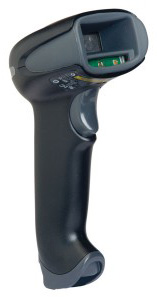1. One Dimensional vs. Two Dimensional Barcode Scanners
There are two main categories of barcode scanners, 1D and 2D.
One dimensional barcode scanners, or linear barcode scanners, can only scan one dimensional barcodes, including:
- UPC Code
- ISBN
- Code 128
- All barcodes consisting of only lines and spaces
Barcode scanners that read two dimensional barcodes are known as 2D imagers, and they are capable of reading both 1D and 2D barcodes. Types of two dimensional barcodes include:
- QR Code
- Aztec Code
- PDF417 (commonly found on driver’s licenses in the United States)
Learn more, read ‘What is a barcode?‘
Linear barcode scanners are the lower-cost option of the two types of barcode scanners, but they are incapable of reading two dimensional barcodes.
Although 2D imagers do have a higher initial cost associated with them than linear scanners, 2D imagers may end up being cheaper in the long run if a need is identified for 2D imaging in the future. For example, this Linear Barcode Scanner from Honeywell lets you upgrade your scanner with 2D capabilities whenever the need is identified, for a cheaper price than buying a whole new collection of barcode scanners.
For more information on 2D Imaging, check out this infographic.
 2. Form Factor
2. Form Factor
Handheld
- Handheld Barcode Scanners are most often found in retail, warehousing, healthcare, and manufacturing environments.
- They are held in the hand of whomever is doing the scanning, and feature a large trigger button that initiates each scan.
Presentation
- Presentation Barcode Scanners are ideal for any task where a barcode is waved in front of a stationary scanner
- One common use for this is in Mobile Marketing Campaigns: the customer takes out his/her phone, places it in front of the presentation scanner, and then the barcode is read and any relevant discounts are applied.
In-counter
- In-counter Barcode Scanners (or Integrated Barcode Scanners) are usually found in grocery stores and other stores with high volumes of barcodes that need to be scanned at checkout, such as department stores
- In-counter scanners often contain built-in scales for weighing out fruit, vegetables, and bulk foods.
 3. Connectivity
3. Connectivity
Wired
- Wired Barcode Scanners are the more economical option of the two types of connection technology. They are more limited in their uses, as they must stay plugged into the computer that is going to collect the data.
- Most wired barcode scanners use USB as their connection type of choice, but there are also scanners available with PS/2 and RS-232 wired connections.
Wireless
- Wireless Barcode Scanners are slightly more expensive than wired ones, but the added benefit they provide can far outweigh the extra cost for many applications.
- If the scanner needs to be moved from the location of the computer it is connected to, then it is recommended to use a wireless barcode scanner.
- Almost all wireless barcode scanners use Bluetooth technology to connect to their base.
- They are available with ranges of 33 feet to over 200 feet to accommodate any application.
 4. Other Devices
4. Other Devices
Mobile Computers & Tablets
Most industrial & enterprise mobile computers have the ability to scan barcodes. This, coupled with the fact that many mobile computers are capable of connecting to cellular networks to transfer data, means that mobile computers offer some of the most versatile barcode scanning of any device, as they can go wherever you do.
Some business-ready tablets also have barcode scanning capabilities, in order to provide many of the same benefits that mobile computers offer.
Questions about barcode scanners? Feel free to contact us and our tech experts will clear up any questions you may have!
Call 800-830-9523 or Email info@L-Tron.com
If you would like to learn more about types of barcodes, you can try out our free Barcode Generator and see what the world of barcodes has to offer!
About the Author:

Cal Goheen is on the marketing team here at L-Tron, specializing in content creation. When he’s not busy writing informative blog posts, you can find him absorbed in his studies at the University of Rochester.













